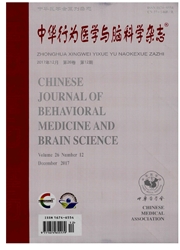

 中文摘要:
中文摘要:
目的应用正电子发射计算机体层显像.计算机体层显像(PET—CT)探讨基底神经节在印度人英语书写中的神经心理学机制,并在此基础上阐释拼音文字书写规律。方法以6名健康的大学本科印度留学生为研究对象,每人分别执行似写和英语书写作业,采用PET—CT进行扫描并获得数据,通过统计参数周对假写和英浯书写的图像数据进行配对t检验,分析葡萄糖代谢变化的区域,获得英语书写所引起的脑功能激活图。结果英语书写与假写比较时,左侧壳核(x=-30,y=-11,z=4,t值=2.34,Z值=1.84,P值=0.033)、尾状核头(x=-8,y=17,z=-4,t值=2.08,Z值=1.70,P值=0.045)葡萄糖代谢增加结论左侧基底伸经节参与英语书写过程,并在右利手人群中具有对侧优势性。
 英文摘要:
英文摘要:
Objective To explore the neuropsychological mechanism of basal ganglia in English writing and elucidate law of alphabetic writing by means of PET-CT. Methods Subjects were six healthy Indian overseas students,sophomore and junior undergraduate. PET-CT examinations of the pseudo-writing and the English writing were carried out sueeessively with an interval of 3 - 5 days. Statistical parametric mapping (SPM) was used to compare the datum of the two tasks through paired-t test. After analyzing areas where the metabolism of glucose changed the images about activated cerebral regions in English writing were obtained. Results The metabolism of glucose in left putamen(x= -30,y= -11,z=d,t=2.34, Z=1.84, P=0.033) and caudate head(x=-8,y= 17, z = -4, t = 2.08, Z= 1.70, P=0. 045) were inc, reased in the comparison hetween English writing and English pseudo-writing. Conclusion Left basal ganglia participates in English writing with contralateral cerebral dominance in right-handedness.
 同期刊论文项目
同期刊论文项目
 同项目期刊论文
同项目期刊论文
 期刊信息
期刊信息
